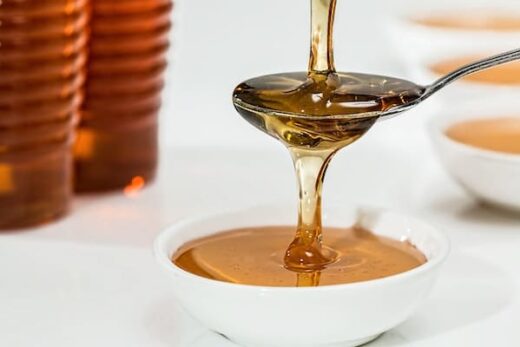
We’re all familiar with the sweet, savory nectar known as honey. Its high sugar concentration and natural origin make it a sure-fire ally for desserts and other delicacies. Some cosmetics brands use it as a base for their body care products. In api-therapy, it’s an inexhaustible source of health benefits. What are the real powers of this beverage? What can we do with it?
The nectar of the gods
The name honey comes from the Greek word “mel” and refers to the substance made by bees from flower nectar. As you’d expect, it’s essentially made up of sugars: fructose and glucose. These two simple sugars, easily assimilated by our bodies, make up 80% of honey. In addition to these two sugars, it contains minerals, vitamins and antioxidants. There are several varieties. The quality of honey depends on the type of bee that produces the flower and the place where it is produced. This is how we can distinguish honeys from cloveracacia, alfalfa, wildflowers, and limemint, pumpkin, eucalyptus, sunflower….the most expensive honey in the world is said to be wild jujube honey. It is produced in Yemen. It is said to have aphrodisiac properties and is extremely rare.
A very good healing agent
This is one of honey’s best-known properties. It contains an enzyme called gluco-oxidase. This enzyme converts glucose into a hydrogen peroxide. It is this water that helps revascularize wounds and form tissue. Hence its healing power.
Honey is currently used in over 20 hospitals in France as a healing agent. As a standard dressing or spread directly on a wound. However, for such use, it is important that it is pure. Contrary to what you might think, it doesn’t improve with age and can even ferment. Store between 8° and 14°, away from light, for around 15 months. This does not mean that it is not consumable outside these conditions. But outside these storage conditions, it loses some of its active ingredients and is no longer necessarily effective.
Finally, it should be noted that honey is suitable for small wounds at home. It in no way dispenses with the need for a medical consultation, which becomes essential if the healing effect is not obtained.
A natural antiseptic
To make honey, bees bring nectar back to the hive. They dehumidify it to preserve it. Dehumidification” consists in regurgitating nectar in their crop and passing it from bee to bee. As it passes from one bee’s mouth to another, the secretions of different bees give it a certain enzymatic richness. In fact, it now contains 2 types of protein. Inhibins inhibit the multiplication of microbes, while defensins reinforce resistance to microbes. It is these two enzymes that give honey its antiseptic power. It is effective for sore throats and against intestinal fermentation.
Honey, an incomparable moisturizer
Honey’s sugar content makes it a good moisturizer for your skin. It binds water molecules to the skin and is ideal for sensitive skin because it is anti-irritant. Its rich antioxidant content makes it an ally against cell aging. In addition, the vitamins and minerals it contains make it a soothing and softening skin care product.
To enhance its properties, you can mix it with other natural products, depending on the desired result. For example:
- to cleanse the skin, mix lemon and honey and apply.
- For an exfoliating treatment, mix honey and oats.
- for an exfoliating treatment, mix honey and clay
- For soft, moisturized skin, a mixture of milk and honey is recommended.
A real source of energy for athletes
Because of its simple sugar content, honey is a source of energy. Fructose and glucose are easily assimilated by the body. Unlike sucrose, there’s no need to wait for digestion. It is highly beneficial for athletes, not only because it provides energy, but also because it strengthens muscles, improves endurance and facilitates recovery. It’s said that during the conquest of the Himalayas, explorers took honey with them, as it’s the only element their metabolism can assimilate rapidly without the risk of hyper/hypoglycemia.

For those who often run marathons, honey will help reduce the effects of fatigue. Taken with herbal tea, it helps you fall asleep.
Honey to add flavour to your dishes
Honey has the ability to sweeten more than white sugar at the same quantity, and with a tiny amount of calories. It can therefore easily replace sugar in your preparations. That’s what we recommend. To achieve this, it is essential to use honey without any additives or preservatives. It can also be used in your recipes. It gives a sweet fragrance and pleasantly enhances the taste.
Precautions concerning honey
Honey may be a very rich food, but you have to take a few precautions with it.
It is known, for example, as the source of infant botulism. This is because the intestinal flora of a child under the age of one is not mature enough to ingest Clostridium botulinum. This is a bacterium found in honey. The germination of this bacterium in a child’s intestine can cause damage up to and including death. This is why children under one year of age should not consume honey.
It’s also important to know that pasteurizing honey in no way alters its quality. On the one hand, it reduces the risk of crystallization by breaking its natural crystals. It also destroys sugar-tolerant yeasts in honey. These yeasts grow during humid periods and can ferment. Pasteurization is therefore designed to improve preservation. But pasteurized honey does not lose its nutritional value, and is not suitable for children under one year of age.
Here’s an exhaustive list of the riches of the sweet nectar that is honey. it’s not just a substitute for sugar, but can provide much more. Maybe it’s time to adopt it if you’re not using it. If not, it might be time to exploit its full potential.